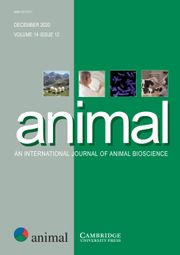Article contents
Comparison of piecewise Weibull baseline survival models for estimation of true and functional longevity in Brown cattle raised in small herds
Published online by Cambridge University Press: 18 June 2013
Abstract
Piecewise Weibull proportional hazard models were used to investigate the effect of genetic and nongenetic factors on functional and true longevity traits of the Slovenian Brown cattle breed. Records of 37 908 Brown cows from 2401 Slovenian herds were used. As these herds were characterised by a relatively small average herd size starting from 6.7 in 1999 and increasing to 8.7 Brown cows per herd in 2008, milk yield classification was made within different herd size groups. The hazard rate was the lowest in the first part of each lactation and was increasing for later stages. Culling risk was lower for cows from herds increasing in size, for cows with higher milk production and for cows from a region with smaller herd sizes and tougher conditions for cattle breeding. The latter result is surprising and may be related to better attention to maintain the animals, despite their lower milk production. The introduction of the milk quota system and drought was found to have an important effect on culling policy between the last seasons of the years 2001 and 2003. Seasonal effects were not related to the milk quota year (from April to March), but to the effect of shortage in fodder during the winter time. The effect of age at first calving and the interaction between year and milk yield class were not found to be significant. Heritability for functional and for true longevity were similar at around 10% each. Inclusion of a correction for class of milk yield to approximate functional longevity increased the herd-year random effect variance by 53%, whereas the sire variance increased by only 14%. The correlation coefficient between ranks of breeding values for functional and true longevity was high (0.91), whereas genetic trends were not found to be significant. To assess their predictive ability, models were compared looking at the survival rate of 4212 second-crop daughters not included in the initial models. The average correlation between estimated breeding values and survival at different stages was 0.39 for true longevity and 0.43 for functional longevity. Results showed that ranking milk yield at population level is appropriate to correct for voluntary culling on low production in small herds.
Information
- Type
- Breeding and genetics
- Information
- Copyright
- Copyright © The Animal Consortium 2013
References
- 19
- Cited by

